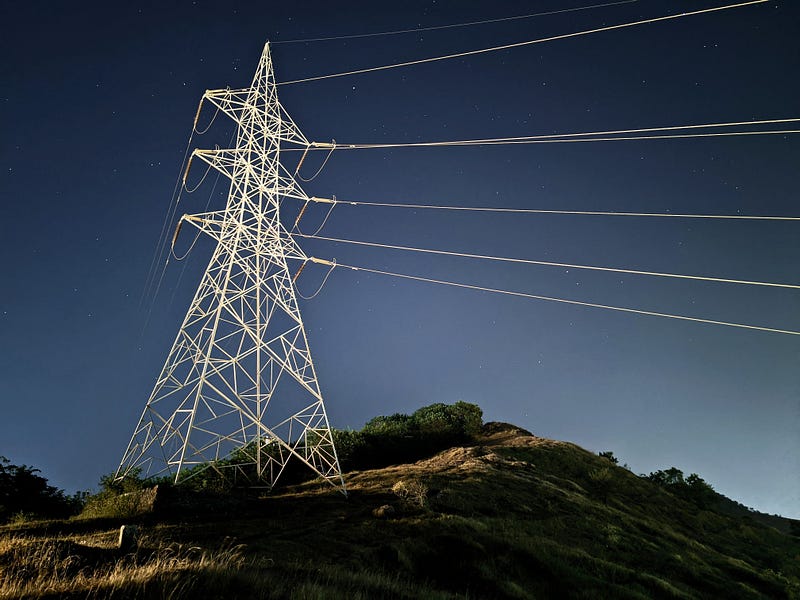# Transitioning to a Renewable Electricity Future: Challenges Ahead
Written on
Chapter 1: The Evolution of Electricity Supply
Transitioning to an electricity system powered entirely by renewable sources poses significant challenges. British scientists and engineers have historically played a crucial role in developing the nation’s electricity infrastructure. The foundational principles established in the 1800s have led to a system that many take for granted today, ensuring that UK residents rarely experience power outages. This reliability is partly due to the effective management of the national grid, which must now adapt to the rapid advancements in technology.

A Brief History of Electricity Generation
The initial efforts to provide electricity to homes began in the 1880s in Surrey and London. A generator in Surrey harnessed water to turn a turbine, while the Holborn Viaduct power station in London became the world’s first to generate electricity through coal combustion. As more generators came online, the landscape became increasingly fragmented; by 1918, London alone had ten different electricity suppliers, each with its own standards. This inconsistency led to challenges, as electrical appliances had to be compatible with various types of supply.
The early electricity generators operated on a principle discovered by Michael Faraday in 1831: electromagnetic induction. This principle states that when a coil of copper wire is placed within a changing magnetic field, it generates an electrical current. Turbines, spinning to create this changing magnetic field, determine the voltage based on the strength of the magnetic field. The debate over whether to use alternating current (AC), which oscillates, or direct current (DC), which does not, was settled in favor of AC due to its efficiency for long-distance transmission.
The Importance of AC in Electricity Distribution
To transmit power over long distances, minimizing resistance is crucial. Higher current levels can increase resistance, so achieving high voltage with low current is ideal. Power, measured in watts (often kilowatts on bills), is derived from both current and voltage (P = IV). Utilizing transformers with AC facilitates this transformation. The independent operation of multiple generators resulted in varying frequencies and voltages until standardization was achieved.
The choice of a standard frequency for AC was influenced by the advent of electric lighting, which was developed around the same time. Early light bulbs relied on electrical resistance to heat a filament until it glowed. If the frequency dropped below 50 Hz, the filament would cool enough to dim, resulting in flickering light. Additionally, steam turbines were optimized to operate at 3000 revolutions per minute (rpm), which, when calculated, led to the adoption of a 50 Hz frequency. Today, Europe’s largest synchronous grid delivers this frequency to approximately 400 million consumers across 24 nations.
Chapter 2: Managing Electricity Demand
The frequency of the National Grid is vital for maintaining a stable electricity supply. An increase in demand can cause frequency fluctuations; if the frequency dips more than 1%, grid stability is compromised. This drop occurs when more power is consumed, such as in the evenings when households are most active. The inertia of steam-powered turbines, despite technological advancements, remains beneficial, as they continue to spin at the required rpm, helping stabilize frequency during sudden demand surges.
The first video, "Why renewables can't save the planet | Michael Shellenberger | TEDxDanubia," discusses the limitations of renewable energy sources in maintaining a stable power supply.
The Role of Renewable Energy
Currently, about 60% of the UK's electricity is generated from traditional steam or gas turbines, which provide the necessary inertia to balance supply and demand. However, renewable sources like solar and wind energy do not offer this inertia. They generate power only under specific conditions, leading to potential instability in the electricity grid. This inconsistency is prompting the development of innovative methods to introduce inertia into renewable energy systems.
Efforts are underway to enhance grid stability through various means. For instance, power stations with steam turbines often operate continuously, even during low-demand periods. Some industrial facilities, like sewage treatment plants, run at night when electricity rates are lower, further balancing out demand. Additionally, excess electricity during off-peak hours is utilized for pumped hydro storage, a system where water is elevated and released to generate power during peak demand times. This method has been employed for around a century, but all viable locations for reservoirs are currently in use.
The second video, "Can You Run a Grid on 100% Wind + Solar? South Australia Shows Us How," explores the feasibility of operating a power grid solely on renewable energy sources.
Looking Ahead: The Future of Electricity Grids
Adapting a national grid initially designed based on 19th-century science to accommodate intermittent renewable energy sources will require significant technological advancements. If the pioneers of electricity could foresee the future, would they have considered implementing a system for distributing DC electricity? Given that solar panels produce DC and many modern devices utilize DC (including LED lighting), transitioning to localized electrical grids powered by DC, supplemented by a larger grid, could enhance efficiency. This shift could minimize the energy losses incurred during the conversion of DC to AC.
About This Article
This article is inspired by discussions from the podcast Technically Speaking, which delves into the intriguing conversations that scientists and engineers have in their laboratories, blending scientific facts with imaginative speculation. New episodes are released biweekly on platforms such as Apple, Spotify, Amazon Music, Google, Podbean, and more. Join the conversation on Twitter to stay engaged.